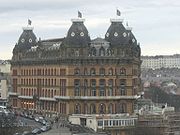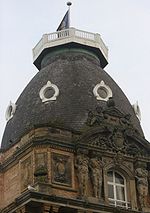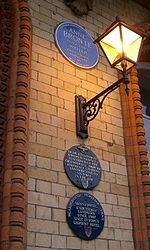
Grand Hotel (Scarborough)
Encyclopedia

Hotel
A hotel is an establishment that provides paid lodging on a short-term basis. The provision of basic accommodation, in times past, consisting only of a room with a bed, a cupboard, a small table and a washstand has largely been replaced by rooms with modern facilities, including en-suite bathrooms...
in Scarborough, England
England
England is a country that is part of the United Kingdom. It shares land borders with Scotland to the north and Wales to the west; the Irish Sea is to the north west, the Celtic Sea to the south west, with the North Sea to the east and the English Channel to the south separating it from continental...
, overlooking the town's South Bay. It is now a Grade II* listed building that is owned by Britannia Hotels
Britannia Hotels
Britannia Hotels is a United Kingdom based hotel company with 37 hotels across the country. Britannia operates at the budget end of the market, with hotels varying in price and star ratings around the country...
, and has undergone a £7 million refurbishment.
The hotel was designed by the Hull
Kingston upon Hull
Kingston upon Hull , usually referred to as Hull, is a city and unitary authority area in the ceremonial county of the East Riding of Yorkshire, England. It stands on the River Hull at its junction with the Humber estuary, 25 miles inland from the North Sea. Hull has a resident population of...
architect Cuthbert Brodrick
Cuthbert Brodrick
Cuthbert Brodrick FRIBA was a British architect, whose most famous building is Leeds Town Hall.- Early life :...
, and when completed in 1867 was one of the largest hotels in the world, as well as one of the first giant purpose-built hotels in Europe. The hotel's distinctive yellow brickwork was made locally in Hunmanby
Hunmanby
Hunmanby is a large village , which was classified as a town until the 1960s, and civil parish in the Scarborough district of North Yorkshire, England...
.
The building is designed around the theme of time: four towers to represent the seasons, 12 floors for the months of the year, 52 chimneys symbolise the weeks, and originally there were 365 bedrooms, one for each day of the year. The hotel itself is in the shape of a 'V' in honour of Queen Victoria.

Victorian era
The Victorian era of British history was the period of Queen Victoria's reign from 20 June 1837 until her death on 22 January 1901. It was a long period of peace, prosperity, refined sensibilities and national self-confidence...
times, when wealthy holidaymakers made up the establishment's clientele. As Scarborough was a famous spa town
Spa town
A spa town is a town situated around a mineral spa . Patrons resorted to spas to "take the waters" for their purported health benefits. The word comes from the Belgian town Spa. In continental Europe a spa was known as a ville d'eau...
, the building's baths originally included an extra pair of taps, so guests could wash in seawater
Seawater
Seawater is water from a sea or ocean. On average, seawater in the world's oceans has a salinity of about 3.5% . This means that every kilogram of seawater has approximately of dissolved salts . The average density of seawater at the ocean surface is 1.025 g/ml...
as well as fresh.
The hotel was badly damaged when the German Navy
Kaiserliche Marine
The Imperial German Navy was the German Navy created at the time of the formation of the German Empire. It existed between 1871 and 1919, growing out of the small Prussian Navy and Norddeutsche Bundesmarine, which primarily had the mission of coastal defense. Kaiser Wilhelm II greatly expanded...
bombarded the town in 1914.
Nowadays, the hotel caters towards the budget end of the spectrum. The hotel was bought by Butlins
Butlins
Butlins is a chain of large holiday camps in the United Kingdom. Butlins was founded by Billy Butlin to provide affordable holidays for ordinary British families....
, the company better-known for its holiday camp
Holiday camp
Holiday camp, in Britain, generally refers to a resort with a boundary that includes accommodation, entertainment and other facilities.As distinct from camping, accommodation typically consisted of chalets – small buildings arranged either individually or in blocks. Some had three or four storeys,...
s, in 1978, and run as an inexpensive choice of accommodation until it was sold to Britannia in 1998.

Blue plaque
A blue plaque is a permanent sign installed in a public place to commemorate a link between that location and a famous person or event, serving as a historical marker....
s outside mark where the novelist Anne Brontë
Anne Brontë
Anne Brontë was a British novelist and poet, the youngest member of the Brontë literary family.The daughter of a poor Irish clergyman in the Church of England, Anne Brontë lived most of her life with her family at the parish of Haworth on the Yorkshire moors. For a couple of years she went to a...
died in 1849, the contribution of the RAF
Royal Air Force
The Royal Air Force is the aerial warfare service branch of the British Armed Forces. Formed on 1 April 1918, it is the oldest independent air force in the world...
trainees stationed at the hotel during World War II
World War II
World War II, or the Second World War , was a global conflict lasting from 1939 to 1945, involving most of the world's nations—including all of the great powers—eventually forming two opposing military alliances: the Allies and the Axis...
, and the original opening of the building.
Controversy
- Several cases of sickness were reported in the mid-1990s under previous ownership, and in 2002 an outbreak of gastro-enteritis hospitalised one man and affected more than 200 guests and staff. A month later, 54 people fell ill, leading to ten days' closure to carry out cleaning.
- In October 2004, a number of guests were quarantineQuarantineQuarantine is compulsory isolation, typically to contain the spread of something considered dangerous, often but not always disease. The word comes from the Italian quarantena, meaning forty-day period....
d in their rooms due to reports of sickness. Following this, in December, the hotel shut for ten days due to an outbreak of the Norwalk virus. This incident, in which no-one required hospital treatment, closed the establishment for several days. A spokesperson for the North YorkshireNorth YorkshireNorth Yorkshire is a non-metropolitan or shire county located in the Yorkshire and the Humber region of England, and a ceremonial county primarily in that region but partly in North East England. Created in 1974 by the Local Government Act 1972 it covers an area of , making it the largest...
Health Protection Unit blamed the incidents on the age of the building and "bad luck".
- In 2005 an investigative BBCBBCThe British Broadcasting Corporation is a British public service broadcaster. Its headquarters is at Broadcasting House in the City of Westminster, London. It is the largest broadcaster in the world, with about 23,000 staff...
report revealed several health issues at the hotel, including the presence of E. coliEscherichia coliEscherichia coli is a Gram-negative, rod-shaped bacterium that is commonly found in the lower intestine of warm-blooded organisms . Most E. coli strains are harmless, but some serotypes can cause serious food poisoning in humans, and are occasionally responsible for product recalls...
bacteria. This report was branded "sensationalist" by Scarborough council's environmental healthEnvironmental healthEnvironmental health is the branch of public health that is concerned with all aspects of the natural and built environment that may affect human health...
officer. - In 2006 the hotel was fined £10,000 after a guest drank water that contained dangerous levels of bleachBleachBleach refers to a number of chemicals that remove color, whiten, or disinfect, often via oxidation. Common chemical bleaches include household chlorine bleach , lye, oxygen bleach , and bleaching powder...
. - In May 2006, a fire broke out on the sixth floor of the building, possibly caused by renovation work. The hotel was quickly evacuated while local fire crews dealt with what they described as "quite a severe fire". Extinguishing the blaze took over 40 minutes, due to the number of stairs in the building and the amount of smoke, which both hampered firefighters' movements.
- In September 2006, the management installed extra netting and spikes on the exterior of the building to deter nesting seagulls. The birds, which are regarded as a nuisance in parts of the town, had been disturbing guests with mating calls. Their droppings were also responsible for a significant proportion of the hotel's cleaning expenses.
- In March 2007, 120 people fell ill with the Norwalk virus; infectionInfectionAn infection is the colonization of a host organism by parasite species. Infecting parasites seek to use the host's resources to reproduce, often resulting in disease...
control specialists stressed that the management should not be held responsible, as similar outbreaks are commonplace elsewhere. - In October 2007 there was another sickness outbreak in the hotel. This was followed in November by another outbreak, affecting several passengers from UK coach companies. Stringent health measures are in place, but appear to be failing.
- In June 2011 seventy guests were affected by an outbreak of vomitting and diarrhoea. The cause was said to most likely to be due to a viral gastrointestinal infection, however that had not been confirmed.
External links
- Britannia Hotels - official site

